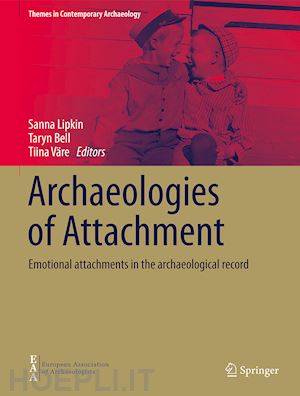

Questo prodotto usufruisce delle SPEDIZIONI GRATIS
selezionando l'opzione Corriere Veloce in fase di ordine.
Pagabile anche con Carta della cultura giovani e del merito, 18App Bonus Cultura e Carta del Docente
This edited volume offers a new approach to the study of emotion in the past, focusing on the experience of emotional attachment. Psychological research has demonstrated that all humans are capable of forming a variety of close social and emotional attachments from cradle to grave, yet archaeology has not, to date, considered the significance of these attachments in any detail. Inspired by Bowlby’s theory of attachment, one of the key theories in developmental psychology over the last 60 years, this volume sheds light on what attachment is, how it functions, and how it has influenced human life and material culture from the Palaeolithic to the present. This volume brings together contributions from authors focusing on a variety of subjects related to attachment, from social relationships with people and animals, to places, to material culture, from the deepest reaches of prehistory to the contemporary era. It aims to improve our understanding of where and how archaeologists can look for evidence of these attachments, and in doing so, it helps us to consider how these shape our understanding of human behaviour, cognition and life more broadly. This volume is of interest to archaeologists and scholars of social attachment theory.
Part I. Introduction.- Chapter 1. Introduction: Archaeologies of Emotion, Attachment, and Social Bonds (Bell et al).- Chapter 2. Archaeologies of Attachment. Understanding Social Relationships, Material Culture, Religion, and Place (Bell).- Part II. Social Bonds.- Chapter 3. Early Modern Breastfeeding Problem in Sweden. Failures to Securely Attach? (Väre).- Chapter 4. Fragile and Resilient: Impact of Childhood Emotional Bonds and Attachment on Coping Mechanisms in Eighteenth to Nineteenth-century Finland (Lipkin).- Chapter 5. Caring, Compassion and Clemency within the Nineteenth-century Foster Family of Clementeoffs. A case of Fictive Kinship (Tuovinen).- Chapter 6. Phenomenological Approaches to Prehistoric Attachments. The Evidence from Prehistoric, Complete, Animal Burials of the Eastern Carpathian Basin (Daróczi).- Part III: Emotionally Important Objects And Places.- Chapter 7. Letting Go of Attachment Objects. Insights from the ‘Problematic Stuff’ of Later Prehistoric Britain and Beyond (Büster).- Chapter 8. Objects of Memory, Attachment, and Childhood. A Case from Roman Piedmont (Northwestern Italy) (Quercia).- Chapter 9. Photography’s Post-Mortem. Examining Emotion and Attachment through Family Pictures (Matila).- Part IV: Interdisciplinary Insights To Attachment-Based Archaeology.- Chapter 10. Conclusion. Towards Mentalising Archaeology: Attachment Bonds and Loneliness (Lipkin et al).- Chapter 11. Commentary. The Application of Attachment Theory for a more Emotionally and Socially Informed Archaeology (Halcrow).
Dr. Sanna Lipkin is University Research Fellow at the University of Oulu and Adjunct Professor in textile archaeology at the University of Turku. In her recent Academy of Finland funded projects (2016–2023) she has specialised in the archaeology of emotional attachment, childhood, funerary archaeology, and the study of mummified remains.
Dr. Taryn Bell is a researcher at the University of York. Her doctoral research, funded by the White Rose College of Arts and Humanities, focused on emotional attachments to objects, with a focus on the Upper Palaeolithic. She is interested in how attachment theory can help archaeologists to understand both social and emotional life in the past.
Dr. Tiina Väre is a post-doctoral researcher at the University of Helsinki. Her main fields of specialty are related to osteology, paleopathology, mummy studies, historical burial culture, and stable isotopes. Her research on past breastfeeding practices in Finland utilising archaeological skeletal remains and stable isotope analyses was funded by the Academy of Finland (2020–2023) and conducted at the University of Oulu.











Il sito utilizza cookie ed altri strumenti di tracciamento che raccolgono informazioni dal dispositivo dell’utente. Oltre ai cookie tecnici ed analitici aggregati, strettamente necessari per il funzionamento di questo sito web, previo consenso dell’utente possono essere installati cookie di profilazione e marketing e cookie dei social media. Cliccando su “Accetto tutti i cookie” saranno attivate tutte le categorie di cookie. Per accettare solo deterninate categorie di cookie, cliccare invece su “Impostazioni cookie”. Chiudendo il banner o continuando a navigare saranno installati solo cookie tecnici. Per maggiori dettagli, consultare la Cookie Policy.